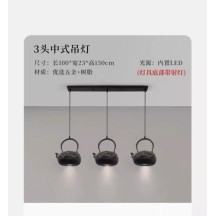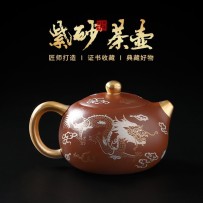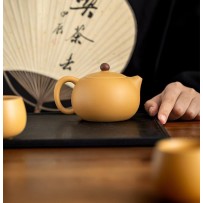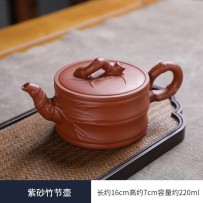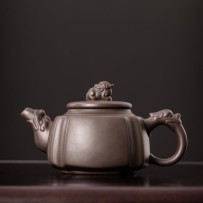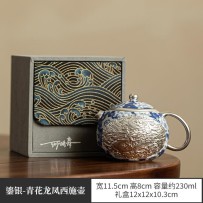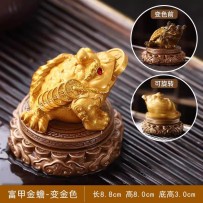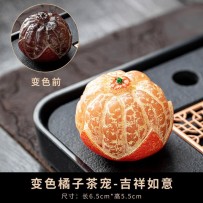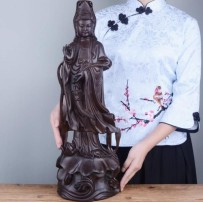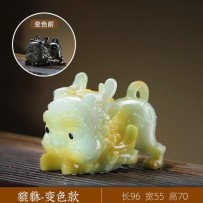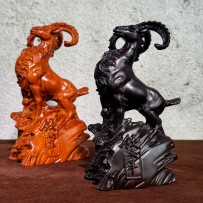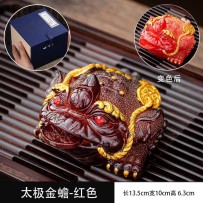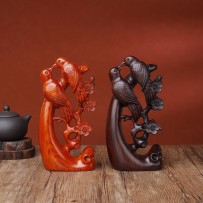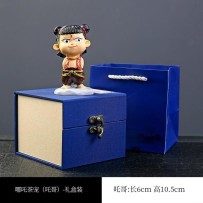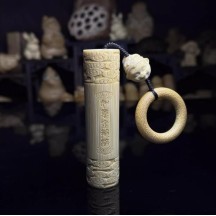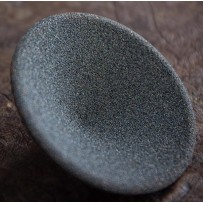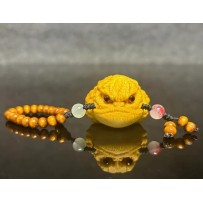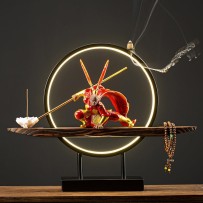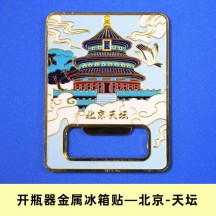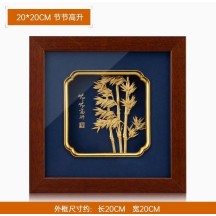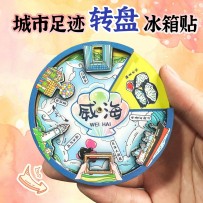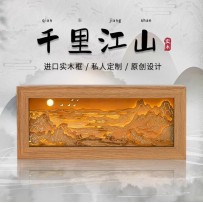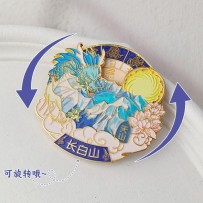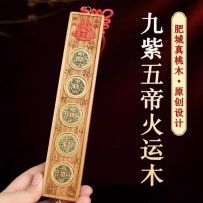The tea utensil holder, made from hickory and walnut wood, features a unique design. Carefully crafted from selected wild hickory, it undergoes over a dozen processes including selection, cutting, polishing, and bonding. Hickory is known for its beautiful grain, varied shapes, and naturally rustic appearance. Paired with walnut wood, the tea holder exudes a sense of antique charm and refined elegance.
Home
Subcategories
Active filters
China is the birthplace of tea. Beyond being an essential daily beverage, tea has also been integrated with the philosophies of Confucianism, Taoism, and Buddhism, making it a vital part of traditional Chinese culture and imbuing it with deep spiritual meaning. As the vessels for tea and water, teaware plays a significant role in the practice of the tea ceremony.
This is a deep-toned tea table ambience lamp, featuring a tin base combined with leaf-textured rock inlays, all sealed with traditional lacquer. Its design is both rustic and elegant, blending ancient charm with modern aesthetics. Versatile and timeless, it complements a wide variety of tea table settings.
Design Concept: A graceful fusion of New Chinese style and classical elegance, intertwined with the fashion of modernism — creating a beautiful encounter in the midst of a bustling modern city. While embracing the fast pace of life, it also offers a moment of elegance and a taste of refined charm.
Diamond Painting replaces traditional embroidery with resin diamonds. Attach gems by numbered codes to create sparkling artworks. All-inclusive kits offer simple, stress-relieving crafting. Finished pieces become framed decor or gifts, blending digital precision with handmade charm. Ideal for all ages to unwind and explore creativity.
Zisha clay, or purple clay, is a type of ceramic that lies between pottery and porcelain. It is characterized by its dense structure, near-porcelain vitrification, high strength, and fine particles. While the surface of the vessel appears smooth and well-formed, it contains subtle granular variations that create a distinctive sandy texture.
Design Concept: Rooted in contemporary lifestyle aesthetics, this design integrates ethnic elements and collaborates with skilled artisans to create pieces that bring new life to the fading brilliance of traditional Chinese craftsmanship, opening up endless possibilities for its integration into everyday life.
Teapots, teacups, and other vessels are the soul of tea brewing. The teapot, as the centerpiece of the tea set, holds both tea leaves and water to steep the tea. Teapots come in a wide variety of shapes and designs, offering both practical functionality and artistic value, enhancing the overall atmosphere and enjoyment of tea appreciation. A good teapot is heat-resistant and retains warmth, allowing the essence of the tea to infuse quickly into the water, releasing its full aroma and showcasing the charm of fine tea to the fullest.
One of the prized clay materials used in Zisha teapots has a jade-green hue, excellent breathability, and a delicate texture that feels as smooth as a baby's skin. After regular use and proper seasoning, it develops a rich patina. It is renowned for its qualities, described as “as hard as iron, as fluid as water, as smooth as jade, and as resonant as a bell.”
A teapot is the perfect companion for brewing tea—serving one tea with one pot symbolizes loyalty, devotion, and family harmony in traditional culture. Therefore, gifting tea and a teapot during festive occasions is more than just a gesture; it conveys cultural heritage and refined taste. Giving teaware is a sign of respect, making it an ideal gift for leaders, elders, or clients.
Porcelain body with silver gilding — the fusion of ceramic and silver creates a unique tea vessel, weaving together the wisdom of artisans passed down through millennia. Elegant yet practical, it feels like a serendipitous encounter. Crafted from clay and silver, it embodies both tradition and innovation.
Tea pets, also known as tea toys, are playful ornaments in Chinese tea culture designed to enhance the enjoyment of tea drinking.
"Artistic value: Due to the adoption of exquisite carving techniques, each piece of work embodies the efforts and wisdom of the carver, possessing unique artistic charm and ornamental value, and is a perfect combination of art and religious culture.
Scarcity: Ebony wood resources are scarce, and the production of large-sized ebony solid wood carved Guanyin ornaments is rather difficult. Therefore, it has a certain degree of scarcity. As time goes by, its collection value may continue to increase."
Tea pets, also known as tea toys, are playful ornaments in Chinese tea culture designed to enhance the enjoyment of tea drinking
In traditional Chinese culture, sheep have always been regarded as a symbol of good fortune. Ebony wood carvings of sheep ornaments carry people's yearning and blessings for a better life. They can be used for home decoration to bring a happy and harmonious atmosphere to the family. They can also be given as gifts to relatives and friends to express good wishes to them.
Tea pets, also known as tea toys, are playful ornaments in Chinese tea culture designed to enhance the enjoyment of tea drinking.
Artistic value: The perfect combination of exquisite carving techniques and rosewood makes each piece of the "Happy Smile" ornament a unique artistic treasure with high appreciation artistic value, which can bring collectors aesthetic enjoyment and artistic edification.
Scarcity: Huanghuali wood is a rare type of wood, especially Hainan Huanghuali, which is hailed as "an inch of wood is worth a penny". Historical and cultural value: Huanghuali wood has been highly regarded since the Ming and Qing dynasties. It is an excellent material for making court furniture and handicrafts, carrying rich historical and cultural connotations. Collecting Huanghuali wood carvings that bring joy to one's face is also a form of inheritance and promotion of traditional Chinese culture.
Tea pets, also known as tea toys, are playful ornaments in Chinese tea culture designed to enhance the enjoyment of tea drinking
The carving is meticulous and detailed: The artisans use their exquisite carving skills to vividly depict the shape of the golden hoop rod. The texture of the rod body, the golden hoops at both ends and other details are all handled with extreme delicacy. Meanwhile, the Heart Sutra text is carved on the surface of the jade bamboo. The lines of the text are smooth and the strokes are clear, demonstrating their superb carving skills.
Tea Strainer: As the name suggests, a tea strainer serves the purpose of filtration. Though often overlooked, it plays a crucial role in the tea set. Its main function is to filter out tea leaves and fine particles from the tea liquor, ensuring a clear and bright brew. This not only enhances the visual appeal of the tea but also improves its taste.
Carving techniques: Artisans employ various carving techniques such as round carving, relief carving, and pierced carving to vividly depict the form and expression of toads. From the toad's eyes, mouth, limbs to the textures on its body, everything is handled with extreme precision. Even the details of its toes are clearly visible, demonstrating superb carving skills.
Tea pets, also known as tea toys, are playful ornaments in Chinese tea culture designed to enhance the enjoyment of tea drinking.
It is made of tough boxwood with fine wood grain and warm color. With meticulous craftsmanship, the Bodhisattva Guanyin's appearance is compassionate and solemn, and the lines of her robes are smooth and natural. The three-piece box is exquisitely designed and can be opened and closed freely. Inside, it can be used to house a Buddha statue, and outside, it can be used as a handle for playing with. It also serves as a portable Buddha niche. In this small space, it fully demonstrates the craftsmanship. It is not only a place of sincere faith but also a precious wood carving with great collection value.
Travel fridge magnets carry a wide range of meanings. They are not only souvenirs from a journey but also vessels of memories and emotions tied to travel, as well as symbols of one’s longing for different cultures and places.
Making three-dimensional gold foil paintings of bamboo requires artisans to possess superb skills and rich experience. From the cutting and pasting of the gold foil to the shaping of the three-dimensional effect, every step requires meticulous operation. The slightest mistake may affect the quality of the work. Therefore, each piece of work embodies the efforts and wisdom of the artisans and reflects the exquisite craftsmanship.
Travel fridge magnets carry a wide range of meanings. They are not only souvenirs from a journey but also vessels of memories and emotions tied to travel, as well as symbols of one’s longing for different cultures and places.
Design inspiration: Mainly derived from the silk painting "A Thousand Miles of Rivers and Mountains" by Wang Ximeng of the Northern Song Dynasty. This renowned painting, with its grand scenes, delicate brushstrokes and brilliant colors, depicts continuous mountains, vast rivers, lush forests and scattered pavilions and terraces, presenting the magnificence and beauty of the mountains and rivers during the Northern Song Dynasty. The 3D stereoscopic light and shadow wood Carving lamp of "Thousand Miles of Rivers and Mountains" is based on this model. It aims to recreate the landscape artistic conception in paintings through the forms of wood carving and light and shadow, allowing people to appreciate the charm of ancient art in modern life.
Fridge magnets are small yet delightful cultural and creative products. They serve not only as decorative items but also as carriers of travel memories, expressions of emotion, and even conveyors of cultural messages.
The Nine Purple Li Fire Cycle: It is a concept in numerology. Ancient people divided 20 years into one cycle, and the period from 2024 to 2043 belongs to the Lower Yuan Nine Cycles. The nine cycles correspond to the Li hexagram in the I Ching's Eight Trigrams and are called the "Nine Purple Li Fire Cycle". During this period, all the phenomena of all things that conform to the element of Li Fire will emerge accordingly.The Five Emperors' Coins: Usually composed of copper coins cast by the five emperors of the prosperous Qing Dynasty, namely Shunzhi, Kangxi, Yongzheng, Qianlong and Jiaqing, they carry the energy of prosperity and are unique cultural symbols. In feng shui theory, they have the effects of promoting wealth, warding off evil energy and praying for good fortune.










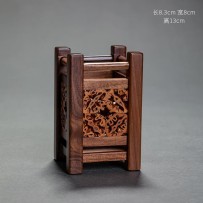

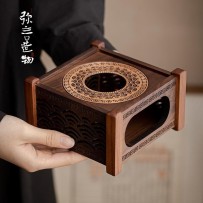

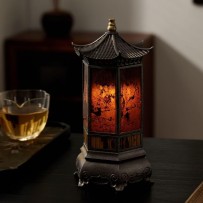

![[Teapot Pendant Light] – Single Hanging Light with Spotlight, Tea Aesthetic Pendant Lamp in Traditional Style](https://chinachic.shop/2665-inner_default/-teapot-pendant-light-single-hanging-light-with-spotlight-tea-aesthetic-pendant-lamp-in-traditional-style.jpg)
